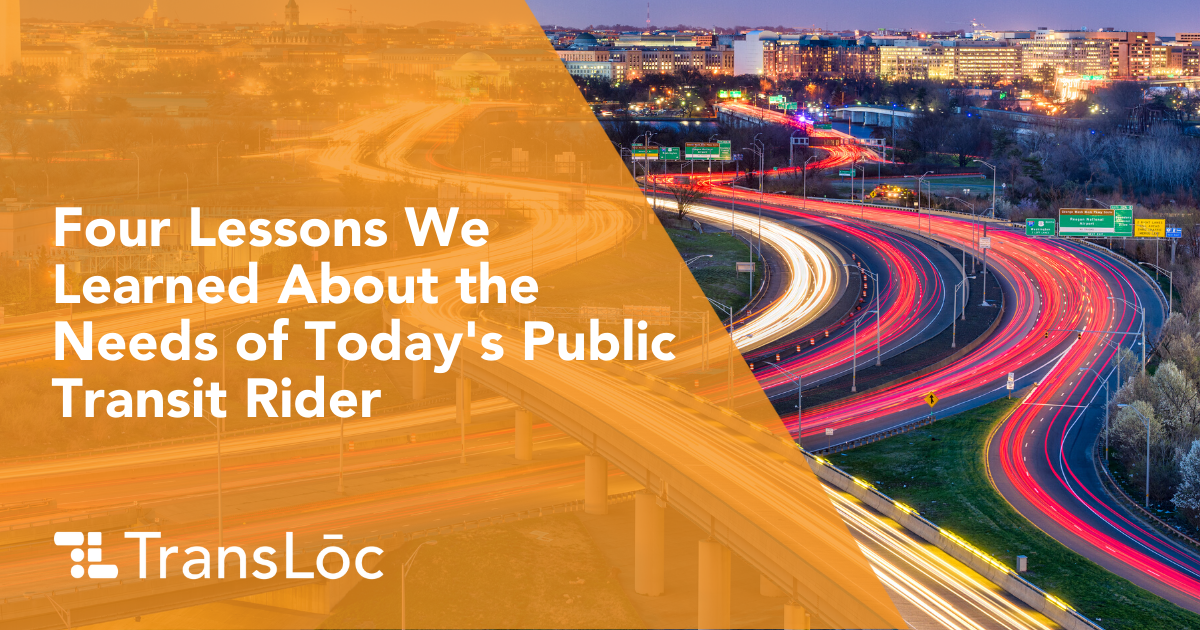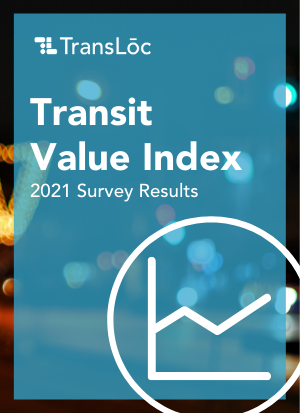
Experts predict that we are on the cusp of a transit evolution led by smart technology and data-driven planning.
But how do the people who use these services everyday feel about public transit’s current state and emerging trends?
In July 2021, we surveyed 1,200 working U.S. adults (ages 18 and older) about their transit usage prior to COVID-19 and new rider expectations post-pandemic. The mobile survey asked riders to share changes in their ridership habits, the role transit has played in their return to work, and the transit innovations they would like to have access to in the future.

The results offer insight into a potential future for public transit that is equal parts challenging, resilient, and promising. Brett Wheatley, TransLoc’s chief executive officer, sees a future that will usher in a new era of innovation for public transit services.
“While U.S. communities face challenges with transit, they are also hopeful that the future will bring innovative solutions that support modern-day needs,” said Wheatley.
Here is what we learned:
Public transit is the most preferred transportation method
Despite a minor decrease in usage compared to pre-pandemic levels (46% to 36%), today’s riders rely on public transit for their current mobility needs more than personal vehicles or carpooling (25%), ride-hailing services (24%), and bikes and scooters (8%).
Public transit can credit its popularity to convenience. A majority of riders said that a public transit stop is within walking distance of their home (65%), the local grocery store (61%), and their workplace (56%).
Health and safety risks could push riders towards private transportation options
As the U.S. continues to grapple with the COVID-19 pandemic, virus exposure (71%) and concerns over the cleanliness of fleet vehicles (71%) will push some transit riders to use private transportation options such as rideshare or personal vehicles.
Another risk that is causing some riders to think twice about reactivating their bus pass is a fear for their physical safety when riding public transit at night (69%).
The time to invest in transportation infrastructure is now
Communities are ready for the transit evolution. A commitment by the U.S. government to improve public transit is a top priority for 46% of riders; 44% would like to see a focus on repairing and upgrading roads and bridges.
Riders understand that mobility equals opportunity, recognizing that an optimized public transit system helps people find jobs (38%), reduces traffic congestion (28%), and encourages more businesses to open in a community (27%).
“At TransLoc, we believe that freedom of mobility is a basic human right and a core function of upward mobility,” said Wheatley. “By improving public transit access, we give our communities a more viable chance at closing economic gaps.”
Many Americans see the benefits of smarter and sustainable public transit services
Riders want to get to their destination quicker, safer, and greener. Considering that 59% of riders admitted to using two to three modes of transportation to get to work, it’s understandable why riders are keeping tabs on how technology is used to enhance the on-time performance of public transit.
Many believe that experimenting with autonomous vehicles (AV) and electric vehicles (EV) is the key to improving public transit service (60% and 70%, respectively). It’s not all talk either — 71% of riders would use an AV bus or shuttle if their local transit agency launched one tomorrow.
However, these technological advancements cannot be at the expense of equity and affordability.
“As transit systems innovate and deploy emerging technologies, from environmentally friendly EVs to groundbreaking self-driving vehicles, we must keep equity and accessibility at the core of transit strategies,” said Wheatley. “[Otherwise] agencies risk exacerbating community inequalities for generations to come.”
For more transit rider data, download the 2021 Transit Value Index.